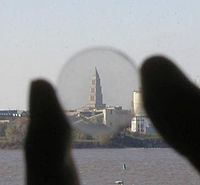
Photo from wikipedia
Abstract Nanostructural morphology and cation (divalent or tetravalent) doping are known to be important factors for photocatalytic and photoelectrochemical activities of iron oxides. Modifications of iron oxides in an appropriate… Click to show full abstract
Abstract Nanostructural morphology and cation (divalent or tetravalent) doping are known to be important factors for photocatalytic and photoelectrochemical activities of iron oxides. Modifications of iron oxides in an appropriate way could significantly improve these activities. In the present work the effects of Cu doping on the microstructural, thermal, optical and photocatalytic properties of goethite (α-FeOOH) and hematite (α-Fe 2 O 3 ) 1D nanoparticles were investigated. Goethite and Cu-doped goethite 1D nanoparticles were synthesized by precipitation in a highly alkaline medium. Hematite and Cu-doped hematite 1D nanoparticles were prepared by calcination of goethite samples at 500 °C. Cu 2+ -for-Fe 3+ substitution in goethite and hematite was confirmed by determining the change in unit cell size using X-ray powder diffraction and by measuring the hyperfine magnetic field reduction using Mossbauer spectroscopy. An increased Cu 2+ -for-Fe 3+ substitution in goethite caused a gradual elongation and narrowing of nanorods with the formation of nanoneedles at 3 or 4 mol% Cu. The shape and size of nanoparticles were not changed by thermal transformation of goethite to hematite. Thermal analysis showed a lower temperature of goethite dehydroxylation upon increased Cu doping. Cu 2+ -for-Fe 3+ substitution in goethite and hematite caused increased absorption of visible and near-IR radiation beyond the absorption edge, as well as a slight decrease in direct and indirect optical band gaps compared with pure phases. The visible light photocatalytic activities of Cu-doped goethite and hematite nanoneedles were significantly improved compared with undoped goethite and hematite nanorods, which could be attributed to a combined effect of nanoneedle morphology and Cu doping.
Journal Title: Journal of Alloys and Compounds
Year Published: 2019
Link to full text (if available)
Share on Social Media: Sign Up to like & get
recommendations!